This post introduces the tool sets available for the most popular enterprise blockchain platforms. All of the enterprise blockchain consortia are building tools to better position their platforms among developers. Ease of use, scalability, and security are all areas of differentiation among the three most popular enterprise blockchain platforms: Hyperledger Fabric; Quorum (Ethereum); and Corda (R3).
Hyperledger Fabric
The Linux Foundation open source umbrella project for blockchain platforms is called Hyperledger, and it exists in multiple instantiations. Hyperledger uses a common tool set across members’ blockchain platforms, effectively creating a platform for tools.
 Source: Hyperledger Architecture – Volume 2 by Hyperledger Consortium
Source: Hyperledger Architecture – Volume 2 by Hyperledger Consortium
The most mature among the Hyperledger platforms is Hyperledger “Fabric,” which has the benefit of also being tightly integrated with Hyperledger “Composer.” Composer is an open toolset intended to make it easy to create, deploy, and manage blockchain platforms.
 Source: Hyperledger Composer architecture and key components
Source: Hyperledger Composer architecture and key components
The Composer framework creates a “Model File” for assets that need to be tracked on blockchain, then builds smart contracts based on JavaScripts tailored to the business requirements, defines access control rules based on data/ transaction governance requirements, and manages queries needed to track things on blockchain. Once defined, the Composer components are bundled as an archive and deployed on Hyperledger Fabric. “Business Cards” are then created to serve as identities for governance. The Composer “Playground” is a browser-based interface used to configure, deploy and manage Hyperledger Blockchain networks.
Web-based applications can interact with Hyperledger Blockchain platforms in real time using Hyperledger “Explorer.” Explorer is used to view, invoke, deploy, and query blocks, transactions and associated data written on to the distributed ledger.
Other Hyperledger platform tools under incubation include “Quilt” for the transaction of data and value across different blockchain platforms, “Caliper” to benchmark performance of Hyperledger platforms, and “Cello” to manage the deployment of Hyperledger components across different infrastructures.
Quorum
Quorum was started by JP Morgan as a private/ permissioned blockchain fork of the Ethereum platform, and is intended to address Ethereum’s scalability and data privacy limitations. “Cakeshop” is an integrated development environment that incorporates a Go Ethereum client and manages nodes, creates and deploys contracts, and provides monitoring capabilities via interface with a Quorum API.
 Source: Quorum Whitepaper - Architecture
Source: Quorum Whitepaper - Architecture
Cakeshop supports “Constellation,” a private transaction mechanism between two or more parties in a private predefined group. Cakeshop also includes a Solidity compiler to generate byte code equivalent to a smart contract written in Solidity language and deployed on an EVM or Docker.
Quorum platform tools under incubation include open third-party tools like Quorum Blockchain Explorer, Quorum Maker and Network Manager.
Corda
Corda was initially focused on blockchain for financial applications and then expanded into supply chain, insurance, healthcare, and government. It also offers a unique paid open-source enterprise-grade blockchain solution.
 Source: Corda node architecture - https://docs.corda.net/key-concepts-node.html
Source: Corda node architecture - https://docs.corda.net/key-concepts-node.html
Key tools available thru Corda include: “Doorman,” a network permissioning service in which nodes must provide detailed Know Your Customer (KYC) data to join and use the network; “ Application Firewall” that operates like a reverse proxy DMZ; “Network Simulator” to show traffic flows between nodes and help visualize network set-up via a map service; “Node Explorer” to view transaction information; and “Load Tester” to stress-test nodes and assess performance under extreme real-world conditions.
 Source: https://medium.com/corda/peer-to-peer-enterprise-blockchain-networking-with-the-corda-firewall-4f6a427ebd97
Source: https://medium.com/corda/peer-to-peer-enterprise-blockchain-networking-with-the-corda-firewall-4f6a427ebd97
Conclusion
With blockchain top of mind these days, but only a small number of blockchain platforms from which to choose, mass adoption hinges on tool chains that determine what can be built, how easily it can be done, and how the resulting products can be managed. Significant differences exist between the scope, security, and scalability of the available tool chains, and those may well determine which platforms win and lose in the race to market success.
Go Deeper
Read my other blogs in this blockchain series:
Blockchain, IoT and Emerging Blockchain Technologies
Can Blockchain Scale to Meet Enterprise Needs?




